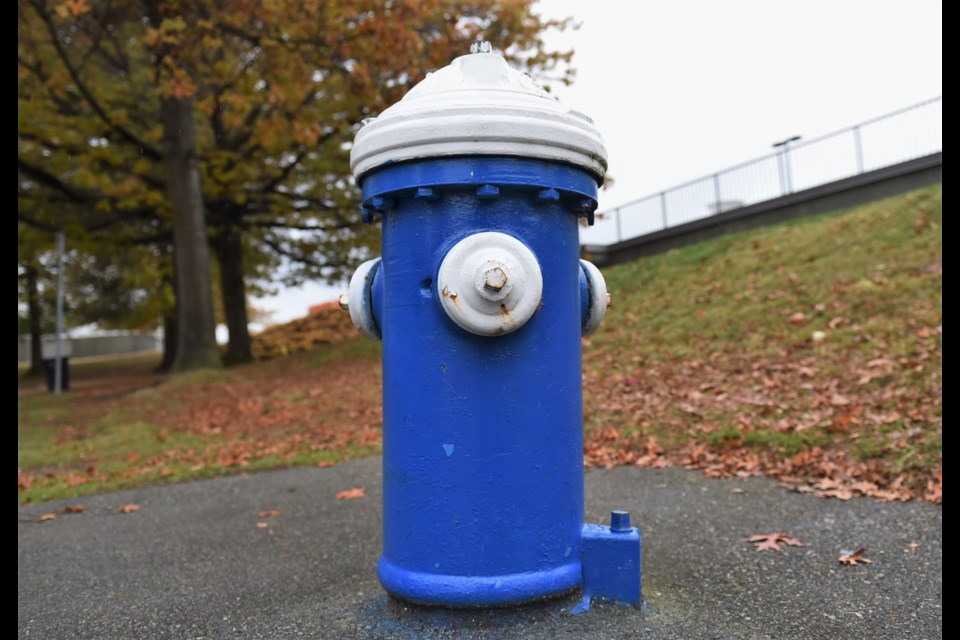The classic fire hydrant is the red one, with one or two nozzle hook-ups.
Sometimes you'll see orange or red and white ones. And if you're in Â鶹´«Ã½Ó³»downtown, West End, Fairview, or Kitsilano neighbourhoods, you might see big blue and white ones, with three nozzles hookups.
That's because they're part of a large, separate network, called the dedicated fire protection system (DFPS), says Â鶹´«Ã½Ó³»Fire Rescue Service spokesperson Matthew Trudeau.
Building the big blue hydrants
It began in 1992, in the extended aftermath 1989's massive 7.1-magnitude Loma Prieta Earthquake in the San Francisco Bay area.
"They basically looked at what San Francisco did as a result of their large earthquake and the understanding was there a need to have a supply of water for firefighting efforts after a large disaster."
The system grew over the next decade, with the last hydrants installed in Kitsilano in 2003.
While there were proposals in the early 2000s to keep expanding it, Trudeau says they fell through.
The system
The system includes separate water mains, (one in Coal Harbour and one in False Creek). There were 65 hydrants, but Trudeau notes a couple have been removed as developments popped up in those neighbourhoods.
The pumping stations are monitored 24/7 and manned five days a week. Each has a huge cavern that holds 150,000 gallons of fresh water, essentially the same water you'd get from a tap. In fact, the whole DFPS holds around 1,000,000 gallons of water at any given time.
As a system built for a huge disaster, there are several specialized aspects to the DFPS. The most important is that it has been built to withstand an 8.5 magnitude earthquake (if an earthquake that size hit Â鶹´«Ã½Ó³»it'd be the biggest to hit and one of the biggest ever recorded globally).
Also, the pumping stations and the caverns play an important role in getting water where it's needed, therefore both can be operated remotely from the other.
Do they use ocean water?
While there's a myth on social media that the blue hydrants always have seawater and that's why they're blue, that's not entirely true.
The caverns can be flooded with seawater, which can then be pumped through the system and used to put out fires if needed, but that's only in an extreme situation, says Trudeau, and has never happened.
In fact, a blue hydrant has only been used once, he notes, over a decade ago. And it wasn't because of a disaster, but rather the location of the hydrant.
Then why are they blue?
The . Red is the lowest (under 500 gallons per minute) and blue is the highest (more than 1,500 gallons per minute).
Why are they big?
They're bigger than the usual hydrants because they have multiple hookups, which require more parts, Trudeau says.
"They are just more things inside of them for control," he explains. "They're almost like three hydrants in one."
Systems for the rest of the city
While blue hydrants don't exist all over the city, that doesn't mean there aren't ways for the VFRS to fight fires during disasters across Vancouver.
Thanks to some very long hoses and remote pumps, they're fairly adaptable when it comes to location. It helps that Â鶹´«Ã½Ó³»has waterfront on three sides; the fire boats or mobile pumps can be used to push water from the Fraser River or Burrard Inlet inland.
And thanks to some huge hoses, they can get it a fair distance inland. They have three hose reels with six 200-meter long 6-inch hoses. Hooked together those would reach 3.6 km. That means from the Fraser River they could lay hose out past 41st Avenue.
There's also a truck that has its own mile-long hose, Trudeau adds.
"We basically have multiple hose reels where we can connect directly to a pumping station, subs (a mobile pump), or trucks," he says. "If everything fails we could use a fire boat."
Essentially, they just need a source of water and they could hook into it.




